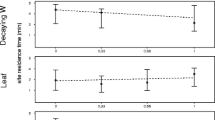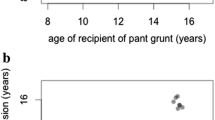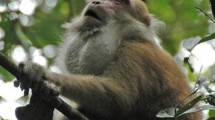Abstract
Dominance rank in female chimpanzees correlates positively with reproductive success. Although a high rank obviously has an advantage for females, clear (linear) hierarchies in female chimpanzees have not been detected. Following the predictions of the socio-ecological model, the type of food competition should affect the dominance relationships among females. We investigated food competition and relationships among 11 adult female chimpanzees in the Taï National Park, Côte d'Ivoire (West Africa). We detected a formal linear dominance hierarchy among the females based on greeting behaviour directed from the subordinate to the dominant female. Females faced contest competition over food, and it increased when either the food was monopolizable or the number of competitors increased. Winning contests over food, but not age, was related to the dominance rank. Affiliative relationships among the females did not help to explain the absence of greetings in some dyads. However comparison post hoc among chimpanzee study sites made differences in the dominance relationships apparent. We discuss them based on social relationships among females, contest competition and predation. The cross-site comparison indicates that the differences in female dominance hierarchies among the chimpanzee study sites are affected by food competition, predation risk and observation time.
Similar content being viewed by others
References
Altmann, J. (1974). Observational study of behavior: Sampling methods.Behaviour 49: 227-267.
Anderson, D. P., Nordheim, E. V., Boesch, C., and Moermond, T. C. (2002). Factors influencing fission-fusion grouping in chimpanzees in the Taï National Park, Côte d'Ivoire. In Boesch, C., Hohmann, G., and Marchant, L. F. (Eds.), Behavioral Diversity in Chimpanzees and Bonobos, Cambridge University Press, UK, Cambridge, pp. 90-101.
Appleby, M. C. (1983). The probability of linearity in hierarchies.Anim. Behav. 31: 600-608.
Bernstein, I. S. (1981). Dominance: The baby and the bathwater.Behav. Brain Sci. 4: 419-457.
Boesch, C. (1991). The effects of leopard predation on grouping patterns in forest chimpanzees.Behaviour 117: 220-242.
Boesch, C. (1994a). Chimpanzees—Red colobus monkeys: A predator—prey system.Anim. Behav. 47: 1135-1148.
Boesch, C. (1994b). Cooperative hunting in wild chimpanzees.Anim. Behav. 48: 653-667.
Boesch, C., and Boesch, H. (1983). Optimisation of nut-cracking with natural hammers by wild chimpanzees.Behaviour 83: 265-286.
Boesch, C., and Boesch, H. (1984a). Mental map in wild chimpanzees: An analyseis of hammer transports for nut cracking.Primates 25: 160-170.
Boesch, C., and Boesch, H. (1984b). Possible causes of sex differences in the use of natural hammers by wild chimpanzees.J. Hum. Evol. 13: 415-440.
Boesch, C., and Boesch, H. (1989). Hunting behaviour of wild chimpanzees in the Tai National Park.Am. J. Phys. Anthropol. 78: 547-573.
Boesch, C., and Boesch-Achermann, H. (2000). The Chimpanzees of the Taï Forest, Oxford University Press, Oxford, UK.
Boesch, C., Nohon, G., Siedel, H., Kpazahi, H., and Vigilant, L. (in preparation). Paternity and male competition among Taï chimpanzees.
Bygott, J. D. (1979). Agonistic behavior, dominance, and social structure in wild chimpanzees of the Gombe National Park. In Hamburg, D. A., and McCown, E. R. (Eds.), The Great Apes, Benjamin/Cummings, Menlo Park, CA, pp. 405-427.
Caraco, T., Martindale, S., and Pulliam, H. R. (1980). Avian flocking in the presence of a predator.Nature 285: 400-401.
Chase, I. D. (1974). Models of hierarchy formation in animal societies.Behav. Sci. 19: 374-382.
Constable, J. L., Ashley, M. V., Goodall, J., and Pusey, A. E. (2001). Noninvasive paternity assignment in Gombe chimpanzees.Mol. Ecol. 10: 1279-1300.
CytelSoftware (1998). StatXact 4. Cytel Software Corporation, Cambridge, MA.
de Vries, H. (1995). An improved test of linearity in dominance hierarchies containing unknown or tied relationships.Anim. Behav. 50: 1375-1389.
de Waal, F. B. M. (1977). The organisation of agonistic relations within two captive groups of Java-monkeys (Macaca fascicularis).Z. Tierpsychol. 44: 225-282.
de Waal, F. B. M. (1978). Exploitative and familiarity-dependent support strategies in a colony of semi-free living chimpanzees.Behaviour 66: 268-311.
de Waal, F. B. M. (1982). Chimpanzee Politics, Jonathan Cape, London.
de Waal, F. B. M. (1986). The integration of dominance and social bonding in primates.Q. Rev. Biol. 61: 459-479.
de Waal, F. B. M. (1989). Dominance ‘style’ and primate social organisation. In Staden, V., and Foley, R. A. (Eds.), Comparative Socioecology, Blackwell, Oxford, pp. 243-263.
de Waal, F. B. M., and Luttrell, L. M. (1985). The formal hierarchy of rhesus macaques (Macaca mulatta): An investigation of bared-teeth display.Am. J. Priamtol. 9: 73-86.
Dow, M. M., and de Waal, F. B. M. (1989). Assignment methods for the analysis of network subgroup interactions.Soc. Netw. 11: 237-255.
Drews, C. (1993). The concept and definition of dominance in animal behaviour.Behaviour 125: 283-313.
Fawcett, K. A. (2000). Female Relationships and Food Availability in a Forest Community of Chimpanzees, PhD Thesis, University of Edinburgh, Edinburgh.
Goodall, J. (1986). The Chimpanzees of Gombe—Patterns of Behavior, The Belknap Press of Harvard Univerity Press, Cambridge, MA.
Hill, K., Boesch, C., Goodall, J., Pusey, A., Williams, J., and Wrangham, R. W. (2001). Mortality rates among wild chimpanzees.J. Hum. Evol. 40: 437-450.
Hiraiwa-Hasegawa, M., Byrne, R. W., Takasaki, H., and Byrne, J. M. E. (1986). Aggression towards large carnivores by wild chimpanzees of Mahale Mountains National Park, Tanzania.Folia Primatol. 47: 8-13.
Huffmann, M. A. (1990). Some socio-behavioral manifestations of old age. In Nishida, T. (ed.), The Chimpanzees of the Mahale Mountains, University of Tokyo Press, Tokyo, pp. 237-255.
Koenig, A. (2000). Competitive regimes in forest-dwelling Hanuman langur females (Semnopithecus entellus).Behav. Ecol. Sociobiol. 48: 93-109.
Koenig, A. (2002). Competition for resources and its behavioral consequences among female primates.Int. J. Primatol. 23: 759-783.
Landau, H. G. (1951). On dominance relations and the structure of animal societies: I. Effect of inherent chrarcteristics.B. Math. Biophys. 13: 1-19.
Lehmann, J., and Boesch, C. (in preparation).Bisexually bonded ranging in chimpanzees (Pan troglodytes verus).
Mitani, J. C., Watts, D. P., and Muller, M. N. (2002). Recent development in the study of wild chimpanzee behavior.Evol. Anthropol. 11: 9-25.
Mitchell, C. L., Boinski, S., and van Schaik, C. P. (1991). Competitive regimes and female bonding in two species of squirrel monkeys (Saimiri oerstedi and S. sciureus).Behav. Ecol. Sociobiol. 28: 55-60.
Mundry, R., and Fischer, J. (1998). Use of statistical programs for nonparametric tests of small samples often leads to incorrect P values: Examples from Animal Behaviour.Anim. Behav. 56: 256-259.
Newton-Fisher, N. E. (2002). Relationships of male chimpanzees in the Budongo Forest, Uganda. In Boesch, C., Hohmann, G., and Marchant, L. F. (Eds.), Behavioral Diversity in Chimpanzees and Bonobos, Cambridge University Press, Cambridge, UK, pp. 124-137.
Nishida, T. (1968). The social group of wild chimpanzees in the Mahali Mountains.Primates 9: 167-224.
Nishida, T. (1979). The social structure of chimpanzees of the Mahale mountains. In Hamburg, D. A., and McCown, E. R. (Eds.), The Great Apes, Benjamin/Cummings, Menlo Park, CA, pp. 73-122.
Nishida, T. (1989). Social interactions between resident and immigrant female chimpanzees. In Heltne, P. G., and Marquardt, L. (Eds.), Understanding Chimpanzees, The Chicago Academy of Science, Cambridge, MA, pp. 68-89.
Nishida, T. (1990). The Chimpanzees of the Mahale Mountains: Sexual and Life History Strategies, University of Tokyo Press, Tokyo.
Nishida, T., and Hosaka, K. (1996). Coalition strategies among adult male chimpanzees of Mahale Mountains, Tanzania. In McGrew, W. C., Marchant, L. F., and Nishida, T. (Eds.), Great Ape Societies, Cambridge University Press, Cambridge, UK, pp. 114-134.
Noë, R., de Waal, F. B. M., and van Hooff, J. A. R. A. M. (1980). Types of dominance in a chimpanzee colony.Folia Primatol. 34: 90-110.
Noldus (1989). The Observer—Software for behavioural research. Noldus Information Technology b.v., Wageningen.
Noldus (1998). MatMan, Noldus Information Technology b.v., Wageningen.
Pruetz, J. D., and Isbell, L. A. (2000). Correlations of food distribution and patch size with agonistic interactions in female vervets (Chlorocebus aethiops) and patas monkeys (Erythrocebus patas) living in simple habitats.Behav. Ecol. Sociobiol. 49: 38-47.
Pusey, A., Williams, J., and Goodall, J. (1997). The influence of dominance rank on the reproductive success of female chimpanzees.Science 277: 828-831.
Range, F., and Noë, R. (2002). Familiarity and dominance relations among female Sooty mangabeys in the Taï National Park.Am. J. Priamtol. 56: 137-153.
Riss, D., and Goodall, J. (1977). The recent rise to the alpha-rank in a population of free-living chimpanzees.Folia Primatol. 27: 134-151.
Siegel, S., and Castellan, N. J. J. (1988). Nonparametric Statistics for the Behavioral Sciences, McGraw-Hill, New York.
StatSoft (1999). Statistica, StatSoft Inc., Tulsa.
Sterck, E. H. M., and Steenbeek, R. (1997). Female dominance relationships and food competition in the sympatric Thomas langur and Long-tailed macaque.Behaviour 134: 749-774.
Sterck, E. H. M., Watts, D. P., and van Schaik, C. P. (1997). The evolution of female social relationships in nonhuman primates.Behav. Ecol. Sociobiol. 41: 291-309.
Sugiyama, Y. (1984). Population dynamics of wild chimpanzees at Bossou, Guinea, between 1976 and 1983.Primates 25: 391-400.
van Schaik, C. P. (1989). The ecology of social relationships amongst female primates. In Standen, V., and Foley, R. A. (Eds.), Comparative socioecology. The Behavioural Ecology of Humans and Other Mammals, Blackwell, Oxford, pp. 195-218.
van Schaik, C. P., van Noordwijk, M. A., Warsono, B., and Sutriono, E. (1983). Party size and early detection of predators in Sumatran forest primates.Primates 24: 211-221.
Vigilant, L., Hofreiter, M., Siedel, H., and Boesch, C. (2001). Paternity and relatedness in wild chimpanzee communities.P. Natl. Acad. Sci. U.S.A. 98: 12890-12895.
Walters, J. (1980). Interventions and the development of dominance relationships in female baboons.Folia Primatol. 34: 61-89.
Walters, J. R., and Seyfarth, R. M. (1987). Conflict and cooperation. In Smuts, B. B., Cheney, D. L., Seyfarth, R. M., Wrangham, R. W., and Struhsacker, T. T. (Eds.), Primate Societies, University of Chicago Press, Chicago, IL, pp. 306-317.
Watts, D. P. (1998). Coalitionary mate guarding by male chimpanzees at Ngogo, Kibale National Park, Uganda.Behav. Ecol. Sociobiol. 44: 43-55.
Watts, D. P., and Pusey, A. E. (1993). Behavior of juvenile and adolescent great apes. In Pereira, M. E., and Fairbanks, L. A. (Eds.), Juvenile Primates, Oxford University Press, New York, pp. 148-167.
Wittig, R. (1997). änderungen der Verhaltensprofile bei Schimpansen einer Gehegegruppe während der Integration zweier fremder Artgenossen.Mitt. Ethol. G. 39: 54.
Wittig, R. M., and Boesch, C. (in press). “Decision-making” in conflicts of wild chimpanzees: An extension of the Relational Model.Behav. Ecol. Sociobiol.
Wrangham, R. W. (1987). Evolution of social structure. In Smuts, B. B., Cheney, D. L., Seyfarth, R. M., Wrangham, R. W., and Struhsaker, T. T. (Eds.), Primate Societies, University of Chicago Press, Chicago, IL, pp. 282-296.
Wrangham, R. W., Clark, A. P., and Isabirye-Basuta, G. (1992). Female social relationships and social organisation of Kibale Forest chimpanzees. In Nishida, T., McGrew, W. C., Marler, P., Pickford, M., and de Waal, F. B. M. (Eds.), Topics in Primatology: Human Origins, University of Tokyo Press, Tokyo, pp. 81-98.
Author information
Authors and Affiliations
Rights and permissions
About this article
Cite this article
Wittig, R.M., Boesch, C. Food Competition and Linear Dominance Hierarchy Among Female Chimpanzees of the Taï National Park. International Journal of Primatology 24, 847–867 (2003). https://doi.org/10.1023/A:1024632923180
Issue Date:
DOI: https://doi.org/10.1023/A:1024632923180




